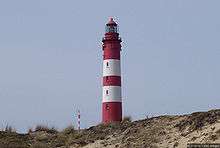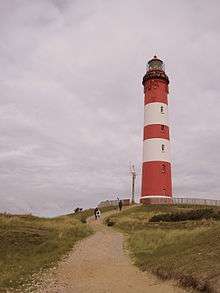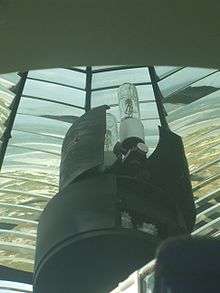Amrum Lighthouse
 Amrum lighthouse Seefeuer Amrum | |
 Schleswig-Holstein | |
| Location | Amrum, Germany |
|---|---|
| Coordinates | 54°37′52.24″N 8°21′16.91″E / 54.6311778°N 8.3546972°ECoordinates: 54°37′52.24″N 8°21′16.91″E / 54.6311778°N 8.3546972°E |
| Year first constructed | 1875 |
| Construction | granite tower |
| Tower shape | tapered cylindrical tower with balcony and lantern |
| Markings / pattern | red tower with two horizontal white bands, red lantern |
| Height | 41 metres (135 ft) |
| Focal height | 63 metres (207 ft) |
| Original lens | First order Fresnel lens |
| Range | 23 nautical miles (43 km; 26 mi) |
| Characteristic | Fl W 7.5s |
| Admiralty number | B 1686 |
| NGA number | 10620 |
| ARLHS number | FED 032 |
| Managing agent | WSA Tönning[1] |
| Heritage |
Kulturdenkmal |
The Amrum lighthouse is located in the southern part of the German island of Amrum, approximately 2 kilometres west of the village of Wittdün, yet still adhering to the municipality of Nebel. Its designation in German is Seefeuer Amrum. It is one of the island's landmarks, being open to the public during the summer season.
Data
The focal plane height of the lightsource measures 63 metres above mean sea level and thereby it is one of the highest lights along the German North Sea shore. The tower itself is 41.8 metres tall, which makes its top reach 67.4 metres above msl. The range of the white sector amounts to 23.3 nautical miles.
The lens is made up of 16 panels of converging lenses. The light character is "Fl, 7.5s", i.e. a single flashing light with an intervall of 7.5 seconds. A 230V/250V halogen metal vapour lamp is used as lantern.[2]
History


An article on the loss of three vessels around the islands of Amrum and Sylt, published in the Hamburger Zeitung in 1868, sparked a controversial debate among experts about where to build a lighthouse in the area. In 1872 it was decided that a lighthouse be built atop a 25 metres high dune on Amrum. Constructions were taken up in 1873 but turned into an obstacle course for all those involved.
Construction and activation
After five weeks only, the construction works had to be halted when the granite stones for the spiral stairs were missing. When the shipment arrived, a number of workers went on strike and refused to set foot on the "dull" island. Yet the remaining workers and some additional auxiliary hands were able to finish the brick building until November 1874, and to install the first order Fresnel lens[3] with its Argand lamp of five wicks. The lens had been displayed at the Paris Exposition in 1867. Also, a dwelling house was built below the dune to host three lighthouse keepers.
The "Amrum Wittdün Lighthouse" (Leuchtfeuer Amrum Wittdün) was officially activated on January 1, 1875, shortly before sunset. It was the first German lighthouse to be erected in Nordfriesland.[3] In 1936, the lantern was electrified and only in 1952 the lighthouse received its red and white marking. The last keeper left the lighthouse in 1984 when the facility had become automated.
The optic
The 2.7 metres tall optic with a weight of 2.9 tonnes is extremely precious. Its current value is put at five million Euro. Some parts have — compared to today's standards — extremely high durability. For example, a ball-bearing which carried the entire optic had to be changed only in 1993, 118 years after the lighthouse's activation.
In popular culture
Amrum lighthouse was featured on two German stamps by Deutsche Post in 2005 and 2008.
See also
References
- Toussaint, Frank and Birgit (2007). "Leuchtturm-Atlas" (in German).
- ↑ Rowlett, Russ. "Lighthouses of Germany: North Frisia". The Lighthouse Directory. University of North Carolina at Chapel Hill. Retrieved January 31, 2016.
- ↑ "Amrum" (in German). Wasser- und Schifffahrtsamt Tönning. Retrieved 17 October 2011.
- 1 2 Rowlett, Russ. "Lighthouses of Germany: North Frisia". The Lighthouse Directory. University of North Carolina at Chapel Hill.
Further reading
- Scheiblich, Reinhard (2003). Leuchttürme an deutschen Küsten (in German). Delius Klasing Verlag. ISBN 3-7688-0920-X.
- Scheiblich, Reinhard; Staack, Hans Helge (2001). Leuchttürme Lexikon (in German). Ellert & Richter Verlag. ISBN 3-8319-0038-8.
- Hoffmann, Bernt; Nikolaus Schmidt (2003). Die schönsten Leuchttürme Deutschlands (in German). Heel Verlag. ISBN 3-89880-221-3.
- Schnall, Uwe (1999). Leuchttürme an deutschen Küsten (in German). Ellert & Richter Verlag. ISBN 3-89234-521-X.
External links
| Wikimedia Commons has media related to Lighthouse Amrum. |

